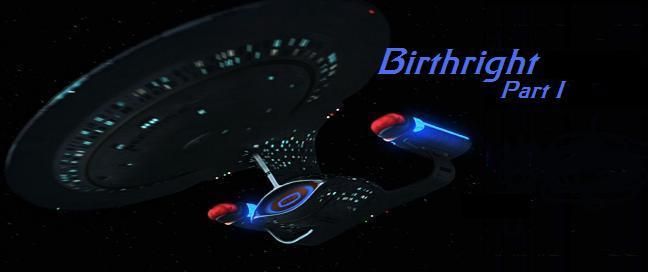
Was on vacation from the last week or so, drastically dropping my "give-a-damn" and "get-to-it'd-ness" to the point I wasn't up to doing the next episode last week. Haven't even shaved since two Sundays ago. Still not back to work till Wednesday. Anyway, usually I watch the episode again to do this, but I watched through S6 not too greatly long ago -whenever the DVDs first came out- and this isn't one I was too quick to want to re-watch. I know it enough i can do it from memory.
The Enterprise is visiting Deep Space: Nine to aid in Bajoran aqueduct repairs. While there, some members of the crew have interesting encounters.
Dr. Julian Bashir -chief medical officer on DS9- wants to use the Enterprise's superior computers to help analyze an artifact brought back from the Gamma Quadrant via the wormhole. While testing the artifact it disperses a bolt of energy that strikes Data which causes him to experience a series of images, including one of his creator -Dr. Noonian Soong. "Inspired" Data tries analyzing the vision(s) he had through painting and such but the only way he can think of truly figure out what happened is to recreate the experiment. The experiment is recreated and this time Geordi and Bashir don't try and to recover Data, allowing the vision to take its course. In the vision Data interacts with Soong where Soong reveals he had built into Data a "dream program" to allow him to have a more human-like experience. The dream-program was set to reveal itself at some point in time and the experiment with the alien artifact simply caused the program to reveal itself earlier.
Data is "excited" for this new aspect of humanity now available to him and now sets aside time during the day for him to "sleep" in order to dream.
Perhaps more importantly, Worf encounters an alien on the DS9 promenade who claims Worf's father is still alive and is being held in a Romulan prison camp. Worf arranges for leave from the Enterprise in order to explore this lead, even though finding his father could mean dishonor for Worf's family line for generations. (As Klingons are not supposed to allow themselves to be taken/held prisoner.)
The informant drops Worf off on the planet, saying he'll return in a few days to retrieve Worf. Worf comes across a Romulan woman bathing in a lagoon and makes her take him to the prison camp where Worf meets a number of Klingons, as well as Romulans, living together in a multi-race community. His father did live there but has died of natural causes, and now since Worf knows of the camp he cannot be permitted to leave.
-----
I think the "Birthright arc" is probably the weakest of the TNG two-parters, especially of the mid-season ones. Mostly because there's little need for this story to be stretched into two parts, Data's story isn't even touched upon in the second part. Maybe this was some attempt at serialized story telling, but considering the show remained episodic for the rest of its run this seems like an odd way to experiment with (for then) more modern story-telling. There's no reason why Data's story couldn't have been stretched to fill a whole episode and Worf's compressed to one.
The crossover is sort-of a gimmick to get people to watch the then-new DS9 but it's sort of a nice touch to help solidify the shared/grander universe for Trek at the time. Though considering DS9 was supposed to be the "frontier" and the Enterprise in deep space exploring or doing what-the-fuck-ever in the Federation, sending them over to DS9 to help with the aqueduct seems like a stretch. But, whatever, we need to get people to watch DS9 and it is interesting to have two shows running concurrently so why not take advantage of this shared timeline?
The introduction of Data's dream program is interesting and while it may help Data to get "more of the human experience" I'm confused as to *why* he needs this. Humans need to dream because it helps the brain to "file away memories" or to organize thoughts or to do any number of things. I suspect the human biological need to dream isn't something Data needs to do in order to operate properly. Does it really make sense for Data to now have to set-aside however much time everyday now in order to "sleep"/dream? And it's hardly an aspect the series takes full advantage of, it's only really used as a plot point in one other episode.
I did enjoy the interaction between Data and Bashir, particularly Bashir's questions about Data which even Data admits are unusual ones he doesn't ordinarily get.
Again, we see the crew messing around with unknown or dangerous devices in engineering a few feet away from the intermix chamber with the device AIMED towards the chamber. I know, I know, standing sets vs. building new ones. But the ship is pretty damn huge. Certainly there's labs for this sort of thing!
I did like the use of the visuals and experiences Data gets in his dream and the artwork he creates in an attempt to understand them. The over-head shot of the Enterprise as Data flies around the outside of it is probably one of my more favorite exterior looks of the ship.
It's a meh episode. It's not terrible and certainly one I could have actually rewatched but, I'm on vacation and feeling sort-of-lazy. In all honesty, the second-part I think works a touch better, overall, but we'll talk about that next week.
Some okay stuff here, but nothing to really blow my skirt-up.
.... Can I watch Tapestry again?

